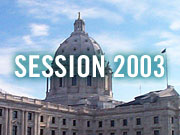Audio
More from MPR
Your Voice
| |||||||||||||||||||||||||||||||||||||||||||||||
School funding nicked in education finance package
May 22, 2003
St. Paul, Minn. — (AP) A wee-hour deal Thursday cleared the way for votes on a nearly $11.9 billion finance package for preschool through adult learning programs, by far the largest chunk of the state's budget. Legislators were hoping to get the plan to Gov. Tim Pawlenty before adjourning for the night.
After accounting for payment shifts - including delaying some aid checks to districts - the bill reduces education funding by $185 million from the current-law level. That's a roughly a 2 percent cut. Before shifts, it's a $621 million cut.
Early childhood and family education programs take a 20 percent hit.
GOP House negotiators touted the plan as "fair and balanced for all schools in the state." Their DFL Senate counterparts took a dimmer view, with Sen. Steve Kelley of Hopkins predicting "an acceleration of class sizes and program reductions" in many districts.
"Some districts will have to do more cuts than they were thinking about," Kelley said. "The governor failed in his promise to protect the classroom."
House Education Finance Chairwoman Alice Seagren, R-Bloomington responded: "The hysteria is a little bit overblown. I am not hearing huge cries of pain."
For K-12 schools, the bedrock per-pupil formula will remain at $4,601 for the next two years. Other funding streams, however, are altered.
Less money will be available for districts that rely on state aid to run after-school and summer-school programs. Extra assistance to offset the cost of teaching students English as a second language will be granted for only five years per student instead of the current indefinite period.
The state will pick up a higher share of local property taxes when districts get levies approved by voters. The levy cap will also rise, helping many suburban districts that have maxed out.
District-by-district allowances weren't immediately released. But it's clear there will be winners and losers.
Urban districts won't get as much to deal with their high concentrations of students from poor families, for instance. Payments tied to special education enrollment will also drop.
But next year, districts can make up for some of their lost aid by approving a "transition levy." In some but not all areas, that will mean an increase local property taxes.
Kelley said Senate DFL negotiators agreed to the package reluctantly.
"We could have stayed here for another two months and not have gotten anything different," Kelley said.
Bob Meeks, a lobbyist for the Minnesota School Boards Association, said it was important that the deal be done now so district leaders can set their budgets for next year. Their new fiscal year begins in July.
The lack of an increase in the basic allowance will force many districts to drain reserves or cut programs and staff, Meeks said.
"We're not going to have any money to meet the inflation costs," he said.
Much will depend on the outcome of teacher contract negotiations. The bill lifts a January 15 deadline for school boards and unions to complete talks.
Another provision in the bill creates a new online learning program, which will allow both public and private school students to take courses over the Internet and not necessarily in their home district.
|
News Headlines
|
Related Subjects
|

